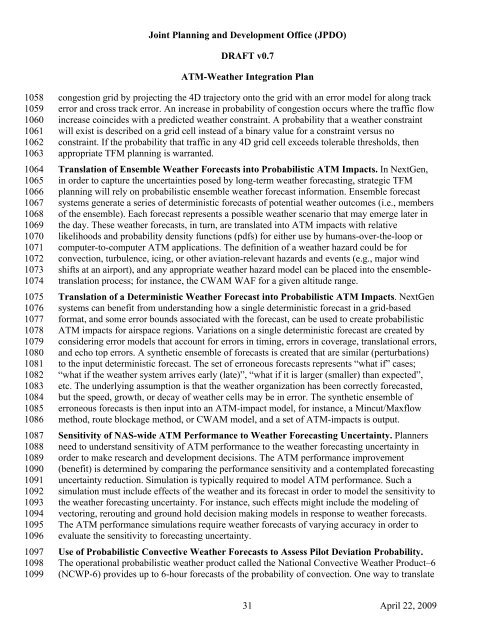ATM-Weather Integration Plan - Joint Planning and Development ...
ATM-Weather Integration Plan - Joint Planning and Development ...
ATM-Weather Integration Plan - Joint Planning and Development ...
You also want an ePaper? Increase the reach of your titles
YUMPU automatically turns print PDFs into web optimized ePapers that Google loves.
<strong>Joint</strong> <strong>Plan</strong>ning <strong>and</strong> <strong>Development</strong> Office (JPDO)<br />
DRAFT v0.7<br />
<strong>ATM</strong>-<strong>Weather</strong> <strong>Integration</strong> <strong>Plan</strong><br />
1058<br />
1059<br />
1060<br />
1061<br />
1062<br />
1063<br />
1064<br />
1065<br />
1066<br />
1067<br />
1068<br />
1069<br />
1070<br />
1071<br />
1072<br />
1073<br />
1074<br />
1075<br />
1076<br />
1077<br />
1078<br />
1079<br />
1080<br />
1081<br />
1082<br />
1083<br />
1084<br />
1085<br />
1086<br />
1087<br />
1088<br />
1089<br />
1090<br />
1091<br />
1092<br />
1093<br />
1094<br />
1095<br />
1096<br />
1097<br />
1098<br />
1099<br />
congestion grid by projecting the 4D trajectory onto the grid with an error model for along track<br />
error <strong>and</strong> cross track error. An increase in probability of congestion occurs where the traffic flow<br />
increase coincides with a predicted weather constraint. A probability that a weather constraint<br />
will exist is described on a grid cell instead of a binary value for a constraint versus no<br />
constraint. If the probability that traffic in any 4D grid cell exceeds tolerable thresholds, then<br />
appropriate TFM planning is warranted.<br />
Translation of Ensemble <strong>Weather</strong> Forecasts into Probabilistic <strong>ATM</strong> Impacts. In NextGen,<br />
in order to capture the uncertainties posed by long-term weather forecasting, strategic TFM<br />
planning will rely on probabilistic ensemble weather forecast information. Ensemble forecast<br />
systems generate a series of deterministic forecasts of potential weather outcomes (i.e., members<br />
of the ensemble). Each forecast represents a possible weather scenario that may emerge later in<br />
the day. These weather forecasts, in turn, are translated into <strong>ATM</strong> impacts with relative<br />
likelihoods <strong>and</strong> probability density functions (pdfs) for either use by humans-over-the-loop or<br />
computer-to-computer <strong>ATM</strong> applications. The definition of a weather hazard could be for<br />
convection, turbulence, icing, or other aviation-relevant hazards <strong>and</strong> events (e.g., major wind<br />
shifts at an airport), <strong>and</strong> any appropriate weather hazard model can be placed into the ensembletranslation<br />
process; for instance, the CWAM WAF for a given altitude range.<br />
Translation of a Deterministic <strong>Weather</strong> Forecast into Probabilistic <strong>ATM</strong> Impacts. NextGen<br />
systems can benefit from underst<strong>and</strong>ing how a single deterministic forecast in a grid-based<br />
format, <strong>and</strong> some error bounds associated with the forecast, can be used to create probabilistic<br />
<strong>ATM</strong> impacts for airspace regions. Variations on a single deterministic forecast are created by<br />
considering error models that account for errors in timing, errors in coverage, translational errors,<br />
<strong>and</strong> echo top errors. A synthetic ensemble of forecasts is created that are similar (perturbations)<br />
to the input deterministic forecast. The set of erroneous forecasts represents “what if” cases;<br />
“what if the weather system arrives early (late)”, “what if it is larger (smaller) than expected”,<br />
etc. The underlying assumption is that the weather organization has been correctly forecasted,<br />
but the speed, growth, or decay of weather cells may be in error. The synthetic ensemble of<br />
erroneous forecasts is then input into an <strong>ATM</strong>-impact model, for instance, a Mincut/Maxflow<br />
method, route blockage method, or CWAM model, <strong>and</strong> a set of <strong>ATM</strong>-impacts is output.<br />
Sensitivity of NAS-wide <strong>ATM</strong> Performance to <strong>Weather</strong> Forecasting Uncertainty. <strong>Plan</strong>ners<br />
need to underst<strong>and</strong> sensitivity of <strong>ATM</strong> performance to the weather forecasting uncertainty in<br />
order to make research <strong>and</strong> development decisions. The <strong>ATM</strong> performance improvement<br />
(benefit) is determined by comparing the performance sensitivity <strong>and</strong> a contemplated forecasting<br />
uncertainty reduction. Simulation is typically required to model <strong>ATM</strong> performance. Such a<br />
simulation must include effects of the weather <strong>and</strong> its forecast in order to model the sensitivity to<br />
the weather forecasting uncertainty. For instance, such effects might include the modeling of<br />
vectoring, rerouting <strong>and</strong> ground hold decision making models in response to weather forecasts.<br />
The <strong>ATM</strong> performance simulations require weather forecasts of varying accuracy in order to<br />
evaluate the sensitivity to forecasting uncertainty.<br />
Use of Probabilistic Convective <strong>Weather</strong> Forecasts to Assess Pilot Deviation Probability.<br />
The operational probabilistic weather product called the National Convective <strong>Weather</strong> Product–6<br />
(NCWP-6) provides up to 6-hour forecasts of the probability of convection. One way to translate<br />
31 April 22, 2009

















